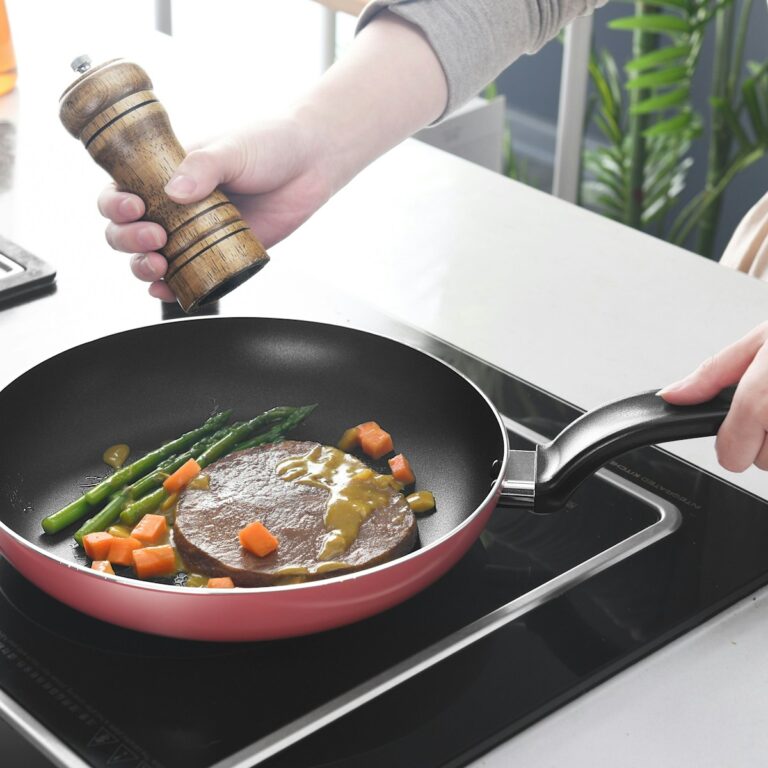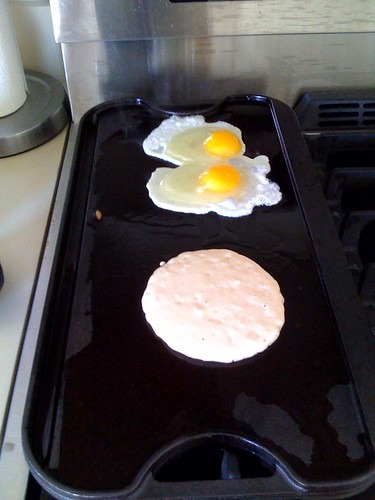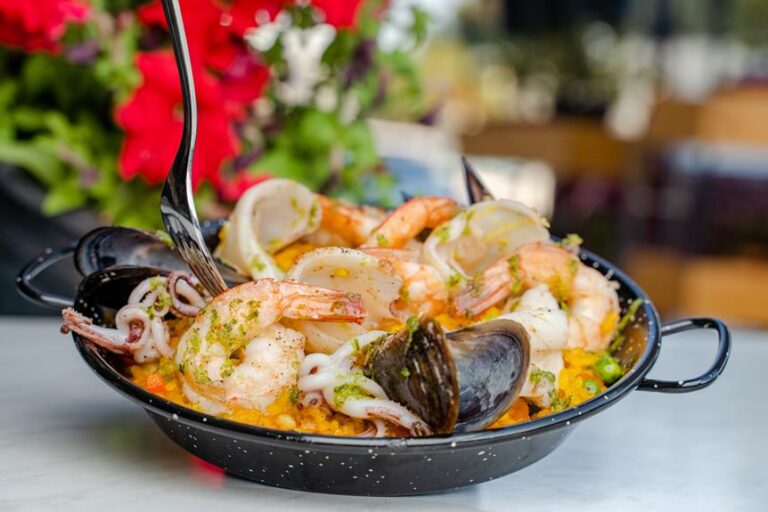When it comes to cooking, choosing the right cookware can make all the difference. In this article, I’ll be exploring the key differences between a saucepan and a frying pan.
From size and shape to cooking methods and heat distribution, we’ll dive into the various factors that can impact your culinary creations.
Whether you’re a seasoned chef or a beginner in the kitchen, understanding the pros and cons of each utensil will help you make the best choice for your cooking style.
Key Takeaways
- Saucepans are taller and narrower than frying pans, which helps prevent splattering and allows for easier stirring.
- Saucepans are versatile for boiling, simmering, and stewing, and offer even heat distribution for consistent cooking.
- Frying pans have a wider and shallower design, making them perfect for foods that require a larger surface area and easy flipping or tossing of ingredients.
- Frying pans can have hot spots and uneven heat distribution, and they lose heat quickly due to their design.
Size and Shape Comparison
When comparing size and shape, the saucepan is typically taller and narrower than the frying pan. This difference in dimensions affects their functionality and purpose in the kitchen.
The taller sides of the saucepan make it ideal for cooking liquids and sauces, as it helps prevent splattering and allows for easier stirring. Its narrow shape also helps with heat distribution and retention, ensuring that the contents are cooked evenly.
On the other hand, the frying pan’s wider and shallower design makes it perfect for cooking foods that require a larger surface area, such as pancakes or stir-fries. Its wide shape also allows for easy flipping and tossing of ingredients.
Cooking Methods and Techniques
To cook your food using different methods and techniques, you can choose between using a saucepan or a frying pan. Both have their own advantages and it ultimately depends on the dish you’re making.
Here are four reasons why I prefer using a saucepan:
- Versatility: A saucepan can be used for boiling, simmering, and stewing. It’s perfect for making soups, sauces, and pasta dishes.
- Even heat distribution: Saucepans usually have a thicker base, allowing for better heat distribution and preventing hot spots. This ensures that your food cooks evenly.
- Lid for steaming: Many saucepans come with a lid, which is great for trapping steam and cooking food faster. It’s ideal for steaming vegetables or making rice.
- Easy cleanup: Saucepans often have a non-stick coating, making them easier to clean. Just a quick wash and you’re done!
Overall, the saucepan is my go-to choice when it comes to cooking various dishes with different methods and techniques.
Heat Distribution and Retention
One advantage of using a saucepan is that it ensures even heat distribution, preventing hot spots and ensuring that your food cooks evenly. This is particularly important when cooking delicate dishes such as sauces or soups, where precise temperature control is necessary. Unlike frying pans, which can have uneven heat distribution due to their wide and shallow shape, saucepans have a taller and narrower design that allows for better heat distribution. Additionally, saucepans are usually made of materials such as stainless steel or copper, which have excellent heat retention properties. This means that once the desired temperature is reached, the saucepan will maintain that heat consistently, allowing for consistent cooking results.
| Advantage | Saucepan | Frying Pan |
|---|---|---|
| Heat distribution | Ensures even heat distribution | Can have hot spots |
| Temperature control | Allows for precise control | Limited control |
| Heat retention | Maintains heat consistently | Heat dissipates quickly |
Versatility in Recipes
When it comes to cooking, two key factors that often come into play are recipe adaptability and cooking technique differences. Understanding how recipes can be adapted to suit different tastes and dietary restrictions is essential for any home cook.
Additionally, being aware of the various cooking techniques and their effects on the final dish can elevate your culinary skills and help you achieve the desired results.
Recipe Adaptability
The saucepan is more adaptable for recipes than the frying pan because it can hold more liquid. This gives me the flexibility to create a wide variety of dishes that require simmering or boiling.
Here are four reasons why the saucepan is a must-have in any kitchen:
- Versatility: With a saucepan, I can make soups, stews, sauces, and even pasta dishes. Its larger capacity allows for the addition of multiple ingredients and flavors to develop.
- Even Heat Distribution: The thick bottom of a saucepan ensures that heat is evenly distributed, preventing hot spots and ensuring consistent cooking.
- Lid for Retaining Moisture: The saucepan comes with a lid, which helps to trap moisture and flavors inside, resulting in more succulent and tender dishes.
- Easy Pouring: The saucepan’s spout and handle make it easy to pour liquids without any spills or mess.
Cooking Technique Differences
To achieve the best results, you should consider the differences in cooking techniques between using a saucepan and a frying pan.
When it comes to cooking, the choice between a saucepan and a frying pan can greatly affect the outcome of your dish. A saucepan is great for slow cooking and simmering ingredients, as it distributes heat evenly and retains moisture.
On the other hand, a frying pan is perfect for quick and high-heat cooking, such as frying, sautéing, and searing. The wide surface area and shallow sides of a frying pan allow for better browning and caramelization. Additionally, the non-stick surface of a frying pan makes it ideal for cooking delicate foods that might stick to a saucepan.
Understanding these differences in cooking techniques will help you choose the right tool for the job and elevate your culinary skills.
Cleaning and Maintenance
When it comes to cleaning techniques, I’ve found that comparing different methods can be quite helpful. Whether it’s using traditional soap and water or opting for specialized cleaning products, knowing which technique works best can save you time and effort.
Additionally, when considering the longevity and durability of a product, it’s important to take into account its ability to withstand frequent cleaning and maintain its quality over time.
Cleaning Techniques Comparison
Cleaning a saucepan is different from cleaning a frying pan because of their distinct materials and surfaces. Here are four key differences in the cleaning techniques for these two kitchen essentials:
- Scrubbing: When cleaning a saucepan, I gently scrub the surface with a non-abrasive sponge or brush to avoid scratching the delicate material, such as stainless steel or copper. On the other hand, a frying pan with a non-stick coating requires a softer touch, using a sponge or cloth to prevent damage.
- Soaking: For stubborn stains on a saucepan, I fill it with warm water and a few drops of dish soap, allowing it to soak for a while before scrubbing. However, soaking a frying pan with a non-stick coating is not recommended as it can compromise the non-stick properties.
- Oil residue: After cleaning a saucepan, I make sure to dry it thoroughly to prevent any oil residue from sticking. In contrast, a frying pan benefits from a thin layer of oil to maintain its non-stick properties.
- Maintenance: It’s important to regularly season a frying pan by applying a thin layer of oil to keep it in optimal condition. However, this step is not necessary for a saucepan.
These differences in cleaning techniques ensure that both my saucepan and frying pan stay in top-notch condition, ready for my next culinary adventure.
Longevity and Durability
The longevity and durability of these kitchen essentials are influenced by their distinct materials and surfaces.
When it comes to saucepans and frying pans, both play crucial roles in my cooking routine.
My trusty saucepan, made of stainless steel, has proven to be a reliable companion over the years. Its sturdy construction and non-reactive surface make it perfect for simmering sauces and boiling pasta.
On the other hand, my favorite frying pan, with its non-stick coating, has been a game-changer for my morning omelets and crispy stir-fries. The non-stick surface ensures easy food release and effortless cleaning.
While both pans have their advantages, it’s important to note that the durability of the non-stick coating may decrease over time. Therefore, proper care and maintenance are essential to prolong their lifespan.
Durability and Longevity
One important factor to consider is how long each type of pan will last. When it comes to durability and longevity, both saucepans and frying pans have their pros and cons. Here are four key points to keep in mind:
- Material: The type of material used in the construction of the pan greatly affects its lifespan. Stainless steel pans are known to be more durable and long-lasting compared to non-stick pans.
- Coating: Non-stick pans are convenient for cooking, but their coating tends to wear off over time. On the other hand, stainless steel pans may require more maintenance but can last for years with proper care.
- Usage: The way you use and care for your pans also plays a role in their longevity. Avoid using metal utensils on non-stick pans and ensure proper cleaning and storage to prolong their lifespan.
- Price: Higher-quality pans generally come with a higher price tag, but they also tend to last longer. Investing in a durable pan upfront can save you money in the long run.
Considering these factors will help you choose the pan that best suits your needs and will last for years to come.
Price Range and Affordability
When it comes to price, it’s important to consider the durability and longevity of the pans you’re considering. As someone who loves cooking, I understand the value of investing in high-quality cookware that will last for years to come.
While it may be tempting to opt for cheaper options, they often lack the durability needed to withstand daily use in the kitchen. Investing in a sturdy and long-lasting saucepan or frying pan may seem more expensive upfront, but it will save you money in the long run as you won’t have to replace it as frequently.
Additionally, durable pans distribute heat more evenly, leading to better cooking results. So, when considering the price range and affordability of pans, don’t forget to prioritize quality and longevity for a worthwhile investment in your culinary journey.
Safety Considerations
As you’re browsing for cookware, it’s crucial to prioritize safety and ensure that the pans you choose are made with non-toxic materials. Here are four safety considerations to keep in mind when deciding between a saucepan and a frying pan:
- Material: Opt for pans made of stainless steel or cast iron, as they are known to be safe and durable.
- Non-stick Coating: Look for pans with a high-quality non-stick coating that is free from harmful chemicals like PFOA and PTFE.
- Handles: Check that the handles are heat-resistant and securely attached to the pan, reducing the risk of burns or accidents.
- Lid: Make sure the pan comes with a well-fitting lid, as it helps to retain heat and prevents splatters while cooking.
Personal Preference and Cooking Style
If you have a personal preference for cooking methods, it’s important to consider your cooking style when choosing between a saucepan and a frying pan. For me, I love to experiment with different recipes and techniques in the kitchen. Sometimes, I enjoy slow cooking dishes that require simmering and braising, which is where a saucepan comes in handy. Other times, I prefer quick and high-heat cooking methods like sautéing and stir-frying, which are better suited for a frying pan. To help you visualize the differences between the two, here’s a comparison table:
| Saucepan | Frying Pan | |
|---|---|---|
| Use | Simmering, boiling, braising | Sautéing, stir-frying, pan-frying |
| Shape | Deep with straight sides | Shallow with sloping sides |
| Lid | Usually comes with a lid | Rarely comes with a lid |
Considering your personal cooking style will ensure that you choose the right tool for the job and enhance your culinary experience.
Conclusion
In conclusion, when it comes to choosing between a saucepan and a frying pan, it ultimately depends on personal preference and cooking style. Both have their own advantages and are suitable for different cooking methods and recipes.
Whether you prioritize heat distribution, versatility, or durability, there is no right or wrong choice. Consider the size and shape, heat retention, cleaning and maintenance, price range, and safety considerations to make an informed decision that suits your needs.



